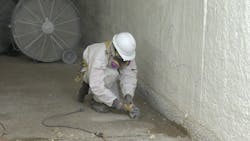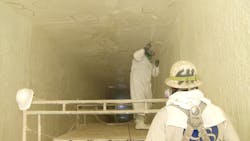Seven wastewater asset management challenges and how to address them
When it comes to maintaining a water utility’s assets, wastewater treatment plants (WWTP) are particularly complex and challenging. There are many reasons for this, from the problems associated with aging infrastructure that apply to a wide variety of assets, to the nature of demands that are characteristic of WWTPs.
These include high operational demands; a system comprising multiple complex treatment processes; the aggressive and often variable nature of the wastewater itself; and sometimes constrained financial resources and limited personnel that lead to postponement of inspection, maintenance and/or delays in repairs. Against this backdrop are further challenges such as ongoing regulatory compliance and the hazardous conditions in which staff may work.
Top wastewater asset management program challenges
1. Run-to-failure mindset
Aging infrastructure and the run-to-failure mindset are certainly not new, and resulting problems impact water infrastructure of all kinds. Like other parts of a utility’s water system, wastewater treatment plants contain outdated or aging components that require frequent repairs and replacements. Maintaining and upgrading these facilities can be complex and costly, especially if they were not designed to accommodate modern treatment technologies or meet current regulatory standards.
Compounding this problem is the once common “run-to-failure” mindset that many utilities adopted when it came to managing their water infrastructure assets. Of course, this approach was costly – not only in the expense of replacing costly assets (sometimes unexpectedly), but also in term of downtime and other related issues.
2. Continuous operation stresses
As critical assets, wastewater treatment plants must operate continuously. The resulting high operational demands and constant flow of wastewater put significant stress on the equipment and processes within the plant.
3. Complex treatment processes
Wastewater treatment involves multiple complex processes, such as preliminary treatment (e.g., screening) to remove larger items, sedimentation, biological treatment, disinfection, and sludge handling. Each of these processes requires specific equipment that must be maintained as well as the expertise needed to operate it effectively.
Ensuring proper functioning and coordination among all components is crucial for efficient treatment, but it also adds to the complexity of maintenance.
4. Wastewater strength and composition
The composition of wastewater entering the treatment plant can vary significantly over time, depending on factors such as weather conditions, industrial discharges, and population changes. Dealing with these variations requires adjusting treatment processes and equipment accordingly, which adds to the challenges of maintenance.
5. Safety considerations
Wastewater treatment plants handle potentially hazardous materials and chemicals. Maintaining a safe working environment for operators and ensuring compliance with safety regulations requires regular inspections, training programs, and adherence to strict protocols. Safety measures further add to the challenges and cost of maintenance.
6. Regulations and compliance
Wastewater treatment plants must meet stringent environmental regulations and discharge standards set by local, state, and federal authorities. Compliance requires continuous monitoring, testing, and adjustment of treatment processes. Any deviations or failures can lead to penalties or environmental harm. Regular repair, maintenance, and monitoring are necessary to ensure compliance.
7. Limited resources.
Many utilities operating wastewater treatment plants face tight budget constraints and limited resources, making it challenging to allocate sufficient funds for proper maintenance activities. Insufficient funding can lead to delayed repairs, inadequate staffing, and compromised maintenance schedules, which can result in equipment failures and reduced treatment efficiency.
Maintaining concrete assets for maximum return on investment
A key aspect of effectively managing wastewater treatment assets is understanding the nature of concrete, often considered to be the most widely used construction material in the world.
In wastewater treatment plants, concrete is commonly used for constructing structures such as primary sedimentation tanks, aeration basins, clarifiers, digesters, and secondary settling tanks.It provides a stable and durable structure for wastewater treatment units and facilitates the settling, separation, and microbial processes involved in wastewater treatment. Consequently, it is not uncommon for concrete to comprise 70% or more of the overall construction materials used in a wastewater treatment plant.
Perhaps because of its wide use and reputation for strength and reliability, there has been a misperception that concrete requires little or no maintenance. However, the opposite is true. Concrete is a highly specialized construction material that requires considerable knowledge and experience to maintain, and also an understanding of its unique nature and the factors that can impact its performance.
For example, concrete is very porous, and as such, it is susceptible to leaks and cracks, hence the common adage, “there are two types of concrete: concrete that has cracked, and concrete that is going to crack.”
In a wastewater treatment plant (WWTP), continuous exposure to wastewater over time can lead to the degradation of concrete surfaces. The presence of acidic or corrosive substances in the wastewater, combined with physical abrasion and freeze-thaw cycles, can cause deterioration of the concrete. Application of protective coatings or liners to the concrete surfaces in wastewater treatment facilities provides an additional layer of protection against chemical attacks and abrasion, and helps to minimize such degradation.
Tailor wastewater asset management plans to the WWTP
Asset management offers a simple yet highly effective and cost-efficient solution to maintaining the most complex systems, including WWTPs.
With appropriate asset management, operators of wastewater treatment plants can enhance their operational efficiency of their facility, extend the lifespan of equipment, minimize maintenance downtime, reduce long-term replacement costs, and ensure consistent compliance with regulatory requirements.
Typical wastewater treatment consists of several steps or processes needed to remove impurities and contaminants from wastewater before it is released back into the environment. These steps range from primary and secondary treatment to nutrient removal and discharge and reuse, and each requires a specific maintenance approach.
USG Water Solutions, a provider of asset management services in the water and wastewater sector, recommends that WWTP rehabilitation and maintenance services be custom-tailored to the chemical and mechanical aggressiveness of each system’s process. Such customized services include:
Plant condition assessments
Using this service, experts work with the treatment plant owner to develop a comprehensive condition assessment based on each asset within the facility. Cracks, surface defects, spalling, or any other sign of concrete or steel distress is recorded along with relevant information on the asset itself (physical exposure, chemical exposure, temperature conditions, etc.). If necessary, samples are collected to conduct additional tests before developing a repair specification.
Custom-designed plant rehabilitation services
There is no “one solution fits all” approach in developing an asset management plan for a wastewater treatment plant. Whether rehabilitation involves concrete rebar, a structural component of a clarifier, or any other treatment plant asset, experienced field crews can clean, repair, prep all surfaces of the asset, and apply specific high-performance coatings/linings for long-term protection.
Recommended upgrades and ancillary services
Qualified experts can recommend upgrades and ancillary services (e.g., blowers, lighting, etc.) to improve the treatment plant operations.
Comprehensive rehabilitation of decaying concrete channels
A large wastewater system in California was facing serious challenges related to aging infrastructure. Some of the technologies employed at their facility were outdated, and several of the key process units needed repair or replacement. A condition assessment showed that the chlorine contact channels at the plant were exhibiting extensive deterioration, posing a threat to continued regulatory compliance.
Chlorine contact channels are a critical component of the treatment process, as they receive the effluent from the secondary clarifiers for disinfection and control of its bacteriological quality prior to discharge. These channels were showing enormous cement loss due to the long detention time of the chlorinated water, thus exposing most of the aggregate in the concrete, which is the backbone of the structure.
In addition to compromising the long-term structural integrity of the unit, the cracks and deterioration were such that they could have resulted in leaks of contaminated effluent into the ground, posing a threat to regulatory compliance and creating a potential environmental hazard.
USG provided a cost-efficient and sustainable approach to solving these problems for this client, which included a comprehensive rehabilitation process of the massive concrete structures. The two-step process involved a thorough surface preparation followed by the application of high performance coatings that safeguard the process units for the long run. To minimize disruption, the rehabilitation process was conducted during dry season and one contact channel at a time.
Because safety is paramount, once the contact channel was shut down and emptied, heavy industrial air blowers and fans were used to dry all interior surfaces and clear the air from toxic chlorine levels. The tunnel was then pressure-washed from top to bottom to remove any loose, deteriorated concrete. A two-step chemical cleaning was then applied to etch and disinfect the concrete substrate. The end result was sound concrete, much like the day it was poured.
Active leaks that were contaminating the channel were treated with a hydrophobic polyurethane grout technology. As part of the general surface preparation process, cracks were repaired by applying a mastic version of a high performance epoxy coating.
The clean surface was then ready for the coating application. A one-coat high performance 100% solids epoxy system was spray-applied on all surfaces at a recommended minimum thickness of one-quarter inch to achieve a restored, uniform surface.
The low VOC, structural monolithic epoxy coating seals all surfaces and provides long-term protection. It enhances the concrete’s water and chemical resistance, allowing the chlorine contact channels to remain protected while submerged in an aggressive environment. The structure is now adequately protected and can maintain serviceability for decades to come.
About the Author
J. Ross Smith
Director of Concrete, Plant and Pipeline Services for USG Water Solutions
J. Ross Smith, PE, is Director of Concrete, Plant and Pipeline Services for USG Water Solutions, where he manages and develops concrete and plant rehabilitation services. He also provides training for clients and water systems consultants in the water/wastewater industry for concrete rehabilitation and coatings. In addition, he troubleshoots challenges discovered in the field for the purpose of maintaining concrete assets. He has worked in the construction industry since 2004, where his experience includes heavy civil construction and new concrete construction, and in water/wastewater asset management since 2008. He can be reached at [email protected].
Joseph Greiner
Concrete Plant Service Center Manager for USG Water Solutions
Joseph Greiner is Concrete Plant Service Center Manager for USG Water Solutions, heading up the delivery arm of USG Water Solutions’ Concrete Plant and Pipeline Services (CPPS) throughout the United States. Has over 17 years of professional experience working as a project manager for over 250 projects between $15,000-$15,000,000 with a focus on protecting concrete assets within the water and wastewater industry. He can be reached at [email protected].


